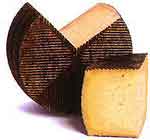 The ‘La Mancha’ region is the home of Manchego, the most important and well-known sheep’s milk cheese in Spain. The shape is very defined, due to the traditional use of esparto grass moulds which imprint a zigzag pattern along the side of the cheese. The small wooden boards used for pressing the cheese provide the wheat ear patterns on the top and bottom.
The ‘La Mancha’ region is the home of Manchego, the most important and well-known sheep’s milk cheese in Spain. The shape is very defined, due to the traditional use of esparto grass moulds which imprint a zigzag pattern along the side of the cheese. The small wooden boards used for pressing the cheese provide the wheat ear patterns on the top and bottom.
The same rustic moulds are used outside of ‘La Mancha’ to produce sheep’s milk cheeses with a similar shape and markings and these are referred to as “Manchego style” cheese.
The true Manchego cheese, though, is made only from whole milk of the Manchega sheep raised in the “La Mancha” region. It is an area with a vast, high plateau and is more than 600 metres above sea level. It adjoins the provinces of Toledo, Cuenca, Ciudad Real and Albacete, all in the Castille-La Mancha Autonomous Region southeast of Madrid. The climate is extreme continental, with cold winters and hot summers.
Manchego cheese is mentioned by Cervantes in his legendary tale “Don Quixote of La Mancha”.
There are two types of Manchego cheese: farmhouse, made with unpasteurized sheep’s milk and industrial, made with pasteurized milk. The cheese is produced in clearly defined homogenous surroundings of wheat fields, fallow land and brush fields.
Manchego is an aged cheese, from semi-cured to cured, and is produced through an enzimatic coagulation. The base milk has to contain a minimum of 6% fat. The milk coagulates at 28 to 32C after the addition of animal curd.
Occasionally, lactic ferments and calcium salts are also added. This results in a compact curdle within 45 to 60 minutes. The curdle must then be cut, and the resulting lumpy paste is then slowly reheated to about 40ºC. The liquid is removed and the dried paste is put into moulds where it is pressed for several hours.
The salting is external, and it is achieved either by rubbing with dry salt, by immersing the cheese in highly salted water, or by a combination of both methods. The percentage of the salt in the weight of the cheese cannot be higher than 2.3% after two months of aging. The aging process takes place in fresh areas, with a humidity level of 75 to 85%, and continues for at least 60 days.
The rind is closed, clean, well engraved and is a yellow to brownish beige colour. The inside is firm, compact and with a few small air pockets unevenly spread. The colour is ivory to pale yellow. The average weight of a Manchego cheese is 3 kg.
Genuine Manchego carries the label “Denominación de Origen Protegida” (D.O.P.)
